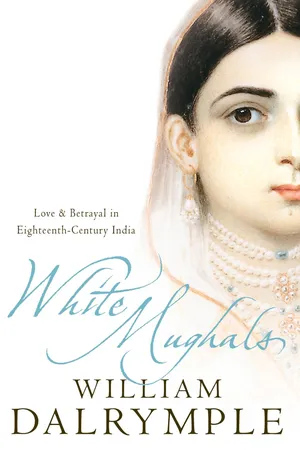![]()
NOTES
INTRODUCTION
1 Mark Zebrowski, Gold, Silver and Bronze from Mughal India (London, 1997)
2 Edward Strachey, ‘The Romantic Marriage of James Achilles Kirkpatrick, Sometime British Resident at the Court of Hyderabad’, in Blackwood’s Magazine, July 1893.
3 That said, though it has yet to be pulled together into a single coherent thesis, there is a growing body of work which has begun to show the degree to which the East India Company officials of the eighteenth century, like the Portuguese before them, assimilated themselves to Mughal culture. Nearly thirty years ago, Percival Spear’s The Nabobs (Cambridge, 1963) painted a picture of hookah-smoking eighteenth-century Englishmen with Indian bibis living it up in Calcutta, while their counterparts in the backwoods mofussil towns and more distant centres of Mughal culture made a more profound transition, dressing in Mughal court dress, intermarrying with the Mughal aristocracy and generally attempting to cross cultural boundaries as part of their enjoyment of, and participation in, late Mughal society.
Subsequent work has refined this picture. Much of this work has centred on Lucknow, where Desmond Young, Rosie Llewellyn-Jones, Seema Alavi, Muzaffar Alam, Jean-Marie Lafont and Maya Jasanoff have between them painted a remarkably detailed picture of a hybrid and inclusive culture where men like Claude Martin, Antoine Polier, Benoît de Boigne, John Wombwell and General William Palmer all, to differing extents, embraced that city’s notably hedonistic take on late Mughlai civilisation. Desmond Young, Fountain of Elephants (London, 1959); Rosie Llewellyn-Jones, A Fatal Friendship: The Nawabs, the British and the City of Lucknow (New Delhi, 1982), A Very Ingenious Man: Claude Martin in Early Colonial India (New Delhi, 1992) and Engaging Scoundrels: True Tales of Old Lucknow (New Delhi, 2000); Muzaffar Alam and Seema Alavi, A European Experience of the Mughal Orient: The I’jaz i-Arslani (Persian Letters, 1773–1779) of Antoine-Louis Henri Polier (New Delhi, 2001); Jean-Marie Lafont, ‘The French in Lucknow in the Eighteenth Century’, in Violette Graff (ed.), Lucknow: Memories of a City (New Delhi,1997) and Indika: Essays in lndo – French Relations 1630–1976 (New Delhi, 2000); Maya Jasanoff’s essay on art-collecting and hybridity in Lucknow will appear in 2002 in Past & Present.
Toby Falk, Mildred Archer and myself have found evidence of a similar process of transculturation in Delhi, particularly in the circle of Sir David Ochterlony, William Fraser and James Skinner that formed around the British Residency from around 1805 until about the time of Fraser’s death in 1835: Mildred Archer and Toby Falk, India Revealed: The Art and Adventures of James and William Fraser 1801–35 (London, 1989); William Dalrymple, City of Djinns (London, 1993). Seema Alavi has also shown the extent to which James Skinner, half-Scottish, half-Rajput, mixed both cultures to create an ‘amalgamation of Mughal and European military ethics’, as well as personally acculturating himself ‘in the manners of high class Muslim society[1, adopting] many of the customs especially the hookah and Mughal cuisine’: Seema Alavi, The Sepoys and the Company: Tradition and Transition in Northern India 1770–1830 (New Delhi, 1995), esp. Chapter 6. Skinner has also been the subject of study by Mildred Archer in Between Battles: The Album of Colonel James Skinner (London, 1982) and Christopher Hawes in Poor Relations: The Making of a Eurasian Community in British India 1773–1833 (London, 1996).
Chris Bayly has shown how useful inter-racial sexual relationships were for gaining knowledge and information about the other side, while Durba Ghosh’s important work on the bibis has shown just how widespread this sort of cross-cultural sexual relationship was at this period: C.A. Bayly, Empire and Information: Intelligence Gathering and Social Communication in India 1780–1870 (Cambridge, 1996); Durba Ghosh, ‘Colonial Companions: Bibis, Begums, and Concubines of the British in North India 1760–1830’ (unpublished Ph.D., Berkeley, 2000). Ghosh has also demonstrated the extent to which this assimilation was a two-way process, affecting the Indian women who came into close contact with Europeans as much as it did the Europeans themselves. Meanwhile, Amin Jaffer’s work has shown the degree to which the domestic material environment Company servants inhabited tended to be something of an Anglo-Mughal amalgam, while in a parallel study Lizzie Collingham has emphasised the assimilation of the British body to its Mughal environment. Linda Colley has demonstrated the degree to which English captives – particularly those imprisoned by Tipu Sultan at Seringapatam – embraced Islam by a combination of force and choice, and the degree to which they took on different aspects of Indian ways of living: Amin Jaffer, Furniture from British India and Ceylon (London, 2001); E.M. Collingham, Imperial Bodies: The Physical Experience ...
